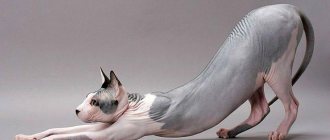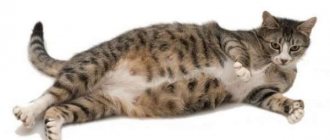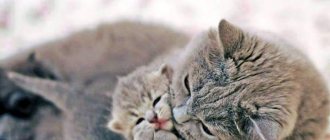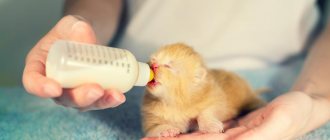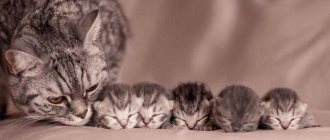The owner of a pregnant cat must be mentally prepared for the fact that one or more kittens may be born non-viable or die immediately after birth.
There are many causes of early mortality in kittens. Their list includes congenital developmental anomalies, birth injuries, improper feeding of a pregnant cat, as well as poor living conditions for animals during the postpartum period. Let's find out how to minimize the risk of death and provide first aid to the kitten so that it does not die.
Causes of mortality in newborn kittens
According to statistics on the mortality of newborn kittens, the largest percentage are stillborn babies or those who died during the first 7 days. This is especially true for purebred purebred animals, whose mortality rate, according to statistics, ranges from 7 to 9%.
Another dangerous period when kittens die is the period from 4 weeks (weaning time) before vaccination.
While kittens are breastfed, death is mainly due to non-infectious factors, since babies receive immunity through mother's milk. Kittens that die between birth and transfer to artificial feeding are called “fading.”
Birth trauma and developmental defects
The reason why kittens die during childbirth may be brain hypoxia due to prolonged retention of the fetus in the mother's birth canal or untimely opening of the amniotic sac. This most often occurs during multiple pregnancies or when the cat is inexperienced.
Persian cats also have a breed predisposition to this pathology.
Important! If the female gives birth for the first time and shows inexperience, then the owner must provide assistance to the animal. It may also be needed during long labors when the cat does not have the strength to rupture the membranes on her own.
No matter how cynical it may sound, most experts say that there is no need to resuscitate a kitten if it is not breathing after birth. During the period when the baby’s body is not saturated with oxygen, irreversible changes occur in the brain. Therefore, if it is possible to bring such a kitten back to life, then saving it in 100% of cases results in serious problems in the form of diseases that are similar to cerebral palsy in humans.
With congenital pathologies of internal organs that are incompatible with life, kittens die in the first days after birth. Such anomalies include:
- cleft lip;
- cleft palate;
- severe narrowing or complete fusion of the anus;
- structural disorders of the cardiovascular system, in which blood does not flow to certain organs;
- pathologies of the respiratory system;
- lack of vital organs.
Important! If a cat gives birth to kittens with the same pathology in two litters, then such a female must be removed from breeding.
Pathologies in which a kitten can be saved by transferring it to additional artificial feeding and placing it in an incubator include:
- the baby’s birth weight is 25% lower than that of other individuals;
- deformations of the ribs or bones of the skull;
- absence of separate limbs.
Important! In each specific case, the owner must independently decide on the advisability of treating and maintaining the life of such kittens. After all, they are more susceptible to infectious diseases than others and often die at an early age. Also, over time, congenital anomalies provoke the appearance of associated pathologies. Most likely, you will have to keep the kitten, since it is difficult to find owners for a pet that requires special care and is not suitable for breeding. Unfortunately, such pseudo-humanity in most cases leads to the ranks of homeless animals. But on the street they quickly die from their stronger relatives or cruel people.
The death of kittens in the first days after birth can also be caused by intrauterine infection with a viral or bacterial infection from the mother, who was ill during pregnancy.
Maternal factor
The cause of death of kittens can be cannibalism of the mother. The female sometimes eats weak babies to provide sufficient nutrition for other individuals. This is what most animals do in the wild, where it is dictated by the need for survival. But sometimes domestic cats destroy their entire litter.
Scientists do not find a single explanation for why this phenomenon occurs. However, it has been noticed that if a female ate her cubs once, she will do so the next time. Therefore, breeders immediately remove such an animal from breeding work.
A young cat's inexperience can also lead to hypothermia and death in kittens.
Sometimes the cause of early death of a kitten is hypogalactia or a low percentage of fat content and nutrient content in milk. This is most often observed in primiparous, emaciated and obese cats.
Triad of hypoglycemia, hypothermia (hypothermia), dehydration
In a newborn kitten, death can occur completely suddenly. But sometimes “fading” babies can die within a few days. They stand out from other individuals by their isolation and anxiety. Such kittens do not have the strength to suckle milk for a long time, they get tired, squeak and crawl to the side.
If the owner notices this syndrome at an early stage, it can be easily eliminated with proper care and feeding. However, further progression of the process provokes rapid dehydration, a decrease in blood glucose levels and hypothermia, the heart rate and respiratory movements gradually decrease, the temperature drops below 34°C, and the baby falls into a coma. This condition is irreversible, so at this stage it is no longer possible to save the kitten from death.
Hypoglycemia
In the first month of life, kittens have no brown fat, and their liver and muscles contain very low amounts of glycogen. As a result, heat in the body of babies is produced only by contraction of skeletal muscles, and not as a result of the breakdown of glucose and fats. And with glucose deficiency, hypoglycemia develops.
Most often this occurs during multiple pregnancy, hypogalactia or delayed lactation.
Symptoms of hypoglycemia in kittens are:
- apathy;
- inactivity;
- convulsions;
- gradual decrease in body temperature.
To save such a kitten, it must be fed with a special milk replacer from a bottle. It is also worth consulting with a veterinarian about the advisability of adding glucose solution to your baby’s diet.
Important! In small kittens, subcutaneous injections of a concentrated glucose solution can cause tissue inflammation. Therefore, preference should be given to oral administration of the drug.
Hypothermia
Imperfect thermoregulation processes in kittens in the first weeks of life can provoke hypothermia.
Low temperature in the room where newborn kittens are kept can lead to hypothermia. This is due to the imperfection of the thermoregulation system in babies during the first weeks of life. An experienced cat leaves her cubs only to satisfy her natural needs. She also gathers the kittens under her and warms them with her warmth.
The baby is at risk of hypothermia if it accidentally falls out of the nest or is far from its mother. Gradually he becomes inactive, and his body temperature drops to 34°C. A cat loses interest in a dying kitten, so owners need to know what to do if the baby dies from hypothermia.
Such a kitten should be wrapped in a warm blanket, placed next to a heating pad and body temperature measured. If this indicator is below 34°C, then you should wait until it rises to 36°C, and then bottle-feed with a breast milk replacer.
Such measures are due to the fact that at low temperatures in the body of babies, the sucking reflex decreases and the digestion process stops. In this case, the milk may enter the respiratory tract, which will cause death, or the product will remain undigested in the stomach, which will also inevitably lead to death.
If the room temperature is below 22°C, then it is necessary to install an artificial heat source. However, it should not be placed in close proximity to the kittens to prevent overheating.
Dehydration
A kitten's water requirement is about 15 ml per 100 g of body weight. In the first weeks of life, a significant amount of moisture evaporates from the surface of the animal's skin. Therefore, babies need a constant supply of it with milk. The owner must also maintain air humidity within 60%.
In case of severe dehydration, the only way to save a kitten is with an intravenous injection of saline solution. If technically this method cannot be implemented, then the drug is administered subcutaneously.
Viral pneumonia
A dangerous disease for fragile small organisms. It occurs as a result of viral infections suffered during illness and lack of vaccinations.
Manifestations of the disease in kittens:
- The animal meows pitifully, does not eat breast milk, and refuses to attach to the nipple.
- Body temperature rises.
- Coughing and sneezing begins.
- Mucus is discharged from the nose.
- The oral cavity becomes covered with ulcers.
- Conjunctivitis and lacrimation develop.
Immediate seeking of professional medical help is required. To prevent the occurrence of viral pneumonia, you need to follow the vaccination schedule, exclude contact of the animal with other pets and people, and monitor the cleanliness and temperature of the room.
What can older kittens die from?
The most common causes of death in kittens over 1.5 months of age are infectious and parasitic diseases. Until this time, babies are protected by the immunity received from mother's milk under the condition of natural breastfeeding.
In the womb, the fetus is reliably protected from pathogenic bacteria by the placental barrier. These microorganisms can enter the baby's body while passing through the birth canal.
The gates for infection are the respiratory tract, an excessively short umbilical cord, the gastrointestinal tract, and the organs of the genitourinary system. If a cat has pathologies in the oral cavity, then it can infect the kitten when it chews the umbilical cord or ruptures the membranes.
Staphylococci and streptococci, which enter the body of kittens with milk from a mother with mastitis, can cause death. Chlamydial infections, which cause conjunctivitis and pneumonia, are also deadly.
If such diseases are detected in a cat, the kittens are immediately separated from their mother and transferred to artificial feeding.
Viral infections
There are a number of dangerous diseases, such as panleukopenia, calcivirus or herpes. Kittens can become infected in utero from an unvaccinated mother. Such cubs are born weakened and die within the first 2-4 days of life.
In the future, the greatest danger for kittens is the period from 2 months to a year, when babies can be infected with these diseases through external factors. Therefore, veterinary specialists insist on vaccinating kittens against viral pathologies, starting at 8 weeks of age.
Parasitic diseases
There are two types of roundworm infection in kittens: intrauterine and neonatal. In the presence of severe helminthic infestations, children do not receive enough nutrients and suffer from intoxication with waste products of parasites. But the most dangerous pathology is intestinal rupture due to a large number of nematodes, which leads to the death of the kitten.
Fleas pose a danger to small kittens as carriers of parasitic and infectious diseases. Therefore, in parallel with deworming, it is necessary to combat ectoparasites.
Fleas can also cause allergic reactions, which sometimes lead to severe swelling and suffocation. Painful flea bites cause itching. Pathogenic microflora easily penetrates into wounds formed by scratching and provokes inflammatory reactions or pyoderma.
Despite the fact that fleas do not directly cause death in kittens, they greatly weaken the immune system and babies become susceptible to diseases of various etiologies.
Intestinal obstruction
When kittens begin to feed and move independently, the risk of them swallowing small foreign objects increases. Representatives of long-haired breeds are more likely to form hard hairballs in the stomach, which get there when licking.
If a foreign object enters the respiratory tract, it can cause suffocation and death. And its penetration into the gastrointestinal tract provokes intestinal blockage. If the kitten is not provided with emergency veterinary care, it will die from intestinal rupture and peritonitis.
Duration and phases of pregnancy
The phases of pregnancy in cats can be divided into 3 main phases.
Week 1-3
There are practically no changes in the cat’s behavior in the first 3 weeks. You may notice less appetite, drowsiness and decreased activity. You can't tell if a cat is pregnant by looking at its nipples. You can notice a change in their color and size only after 3-4 weeks.
At 3 weeks, cats may begin to vomit. It usually lasts 3-4 days or can be one-time. The symptom is associated with stretching of the uterus and hormonal changes in the animal’s body.
Week 4-6
At 5-6 weeks, small embryos can already be felt in the cat’s abdomen. This must be done very gently and carefully. Starting from the 5th week, cats' bellies begin to round. However, sometimes this is not noticeable at all until 7-8 weeks. This is especially true for cats pregnant with only 1 kitten.
Week 7-9
After the 7th week of pregnancy, you can even feel the number of kittens in the cat’s stomach by gently feeling their heads. The movement of the fruit becomes distinct and very noticeable.
The cat's behavior begins to change at 8 weeks. Before giving birth, she becomes restless and follows the owner's heels. At week 9, the cat may become apathetic and very detached from the family and other pets. This reaction is completely normal.
Our pets can only rely on us. Only the owner can help an animal if it is scared, in pain, or if something threatens its life. In the same way, a cat needs human help during childbirth. A responsible and caring owner who is ready for the birth of his pet is the first assistant. Proper preparation for the birth of kittens can save the lives of babies and their mothers.
Childbirth is an extremely important and responsible process in the life of every cat. The health of both the offspring and the mother herself depends on the “quality” of their passage. Veterinary practice proves that in almost 99% of cases, the process of giving birth to kittens goes well without providing additional assistance to the animal. But what if a cat has a premature birth?
What to do if a kitten dies
Experts strongly do not recommend resuscitating a kitten that dies in the first 3 days after birth. But cubs that get sick later can be saved if you contact a veterinarian in a timely manner. The reasons for contacting are the following symptoms:
- diarrhea and vomiting;
- temperature rise above 39°C or drop below 36°C;
- bleeding;
- convulsions, paralysis;
- loss of orientation in space, unsteadiness of gait;
- discharge from the nasal cavity, eyes or ears;
- lack of weight gain;
- injuries.
Important! One of the main criteria for assessing a kitten’s condition is its appetite. If the baby refuses food, then this already serves as an alarming signal.
If the kitten dies, it is necessary to warm it up, take its body temperature (rectally), call the veterinarian and follow his further instructions. In order to prevent the early death of a kitten, and if necessary, save several babies from death, owners need to take the issue of breeding very seriously.
Note! If you don’t have a heating pad or a bottle of warm water at hand, you can cuddle the baby close to you. It has been noticed that “living” human warmth miraculously saves from hypothermia.
How to come to terms with loss
But sometimes kittens die, despite competent and timely help. There is no universal way to help ease the pain of loss. But those who have encountered such grief are advised to adhere to certain rules.
First, you should understand that it is normal to experience grief. Therefore, a person must give himself permission to suffer for a certain amount of time. It is advisable not to keep emotions to yourself, but to cry or shout them out in some deserted place (in the forest, in a closed car, or in a house when there is no one in it). Exercising or performing monotonous activities can also help distract you.
Important! If children suffer from the loss of a little pet, then they should not be reprimanded with cynical remarks. In this case, maximum care should be directed to the child, provide him with support and maintain his mental health.
Secondly, it is necessary to get rid of the feeling of guilt for the death of the kitten. Paradoxically, the more effort a person makes to save his pet, the more he reproaches himself subsequently. You need to understand that the law of natural selection exists in nature and it is pointless to argue with it.
Thirdly, you should get a new furry pet. Some people, having experienced the loss of one kitten, do not dare to have another baby for fear of going through the pain again. But, as practice shows, the happiness that a new “family member” brings overcomes the bitterness of loss. In addition, new worries take up all my free time.
Also, after the kitten has died, the owner needs to decide what to do with the deceased animal. Most cities have laws that prohibit burying pets in flowerbeds and parks within the city. Therefore, it is best to take the kitten’s corpse outside the populated area and bury it in a picturesque place.
In large cities there are crematoriums and cemeteries for pets. This is an expensive procedure, but many wealthy people prefer to use such institutions.
They say that a dead animal runs to heaven on a rainbow. There is no need to darken his path with bitter tears. It is better to remember the happy moments spent together.


